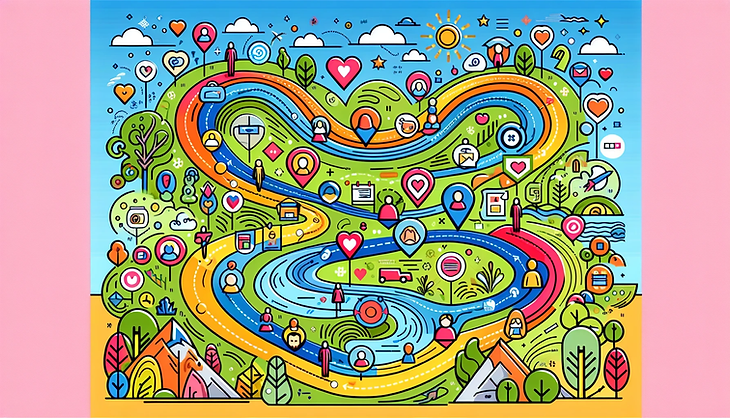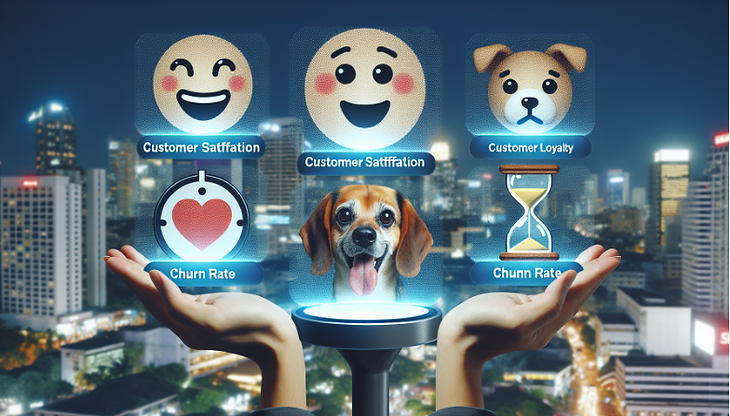Imagine your customers as explorers navigating through your business landscape, encountering various touchpoints and experiences that shape their overall impression of your brand. Crafting customer journey maps, a visual representation of your customers’ interactions with your company, can help you enhance their experience and boost customer retention. In this insightful guide, you’ll learn about the key components of customer journey maps, the steps to create one, the tools and software available, and real-life examples to inspire your own mapping process.
Key Takeaways
-
Customer Journey Maps are composed of five key components: Personas, Touchpoints, Stages, Emotions and Channels.
-
Steps to create an effective Customer Journey Map include researching data collection, visualizing the journey, analyzing and identifying opportunities for improvement. Implementing changes and measuring results.
-
Common challenges in Customer Journey Mapping can be addressed through cross-functional collaboration & usage of pertinent data to drive customer loyalty & satisfaction.
Key Components of a Customer Journey Map

A customer journey map is a powerful tool to visualize and understand your customer’s journey, from their initial interaction with your brand to their ultimate loyalty. Utilizing a customer journey map template can help streamline the process. It consists of five key components:
-
Personas
-
Touchpoints
-
Stages
-
Emotions
-
Channels
These elements help you capture the entire customer journey, analyze their interactions, and identify gaps that need improvement. One of the benefits of customer journey mapping is that it allows you to view the process from the customer’s perspective, enabling you to create a more positive customer experience and increase customer retention.
The creation of an all-inclusive customer journey map requires thoughtful consideration of each component and the collection of pertinent customer data. This will enable you to better understand your customers’ expectations and emotions at different stages of their journey, allowing you to tailor your marketing and customer service strategies accordingly. Concentrating on these pivotal components equips you sufficiently to craft an efficient customer journey map, which fosters beneficial outcomes for your enterprise.
Personas
Personas are fictional characters that represent your target customer segments, based on market research and customer feedback. These personas help you tailor your customer journey map to specific target audiences, allowing you to address their unique needs and preferences. Instead of merely catering to the average customer, creating personas allows you to develop a deeper understanding of your customers, stepping into their shoes and seeing the world from their perspective.
Accurate persona creation necessitates customer surveys and the collection of their feedback. Use this information to develop detailed profiles, including demographic data, preferences, and pain points. Remember to limit the number of personas you create – typically, no more than three – to maintain simplicity and avoid diluting the effectiveness of your customer journey map.
Touchpoints
Touchpoints are the interactions between your customers and your company, occurring at various stages of the customer journey. These interactions can be positive or negative and play a crucial role in shaping the customer’s experience with your brand. Identifying touchpoints provides insights into customer engagement with your company, enabling the enhancement of these interactions.
Touchpoint identification requires a compilation of a list including currently used customer touchpoints and those that are under-utilized. Analyze these touchpoints to determine their impact on the customer experience, and use this information to optimize your customer journey map. By addressing customer pain points and enhancing touchpoints, you can create a more seamless and enjoyable experience for your customers.
Stages
Stages represent the different phases of the customer journey, such as:
-
Awareness
-
Consideration
-
Decision
-
Retention
-
Loyalty
Each stage corresponds to a specific point in the customer lifecycle, from the moment they become aware of your brand to their ongoing relationship with your company. Comprehension of these stages is key to understanding customer interaction with your brand and their purchasing steps.
To create an effective customer journey map, you should:
-
Identify the key stages that your customers go through
-
Map out the touchpoints and emotions associated with each stage
-
Gain a comprehensive understanding of the customer’s journey
-
Optimize the experience at each stage
-
Drive customer loyalty
Emotions

Emotions are integral to the customer journey as they aid in acknowledging and addressing customer feelings at every touchpoint. By understanding the emotions associated with different touchpoints, you can:
-
Identify areas where customers may have negative experiences
-
Work to resolve these pain points
-
Create a more positive customer experience
-
Encourage customer loyalty and satisfaction
To effectively incorporate emotions into your customer journey map, you can use a five-point scale to assign an emotion to each touchpoint, creating a line chart that represents the customers’ emotions throughout their journey. By doing this, you’ll gain a thorough understanding of how customers feel at different stages of their journey, allowing you to make data-driven decisions to improve the overall customer experience.
Channels
Channels encompass the diverse platforms and methods, like websites, social media, and customer service, used by customers to interact with your company. These channels provide numerous touchpoints through which customers can engage with your brand, shaping their experience and opinion of your company. By strategically managing and optimizing these channels, you can create a seamless and personalized customer journey.
To effectively incorporate channels into your customer journey map, follow these steps:
-
List all the platforms and methods through which customers engage with your company.
-
Analyze the impact of these channels on the customer experience and identify areas where improvements can be made.
-
By optimizing these channels and ensuring a consistent and positive experience across all touchpoints, you can enhance the overall customer journey and drive customer loyalty.
Steps to Create an Effective Customer Journey Map
Having grasped the key components of a customer journey map, it’s appropriate to construct one for your enterprise. The process involves four main steps:
-
Research and data collection
-
Visualization
-
Analysis
-
Implementation of changes
By following these steps, you can focus on creating a customer journey map that helps you identify areas for improvement and optimize the customer experience.
Maintaining the customer’s perspective is necessary throughout the customer journey mapping process. This will enable you to better understand customer needs, preferences, and emotions, allowing you to make data-driven decisions that enhance the customer experience. By focusing on the customer’s journey and addressing their pain points, you can drive customer loyalty and satisfaction.
Research and Data Collection
Research and data collection is the initial step in the creation of a customer journey map. This involves gathering information about your customers’ behavior, preferences, and feedback through a variety of methods, such as surveys, interviews, and analytics. By collecting this data, you can gain a deeper understanding of your customers and their needs, allowing you to create a more accurate and effective customer journey map.
To effectively collect customer data, consider utilizing both solicited and unsolicited data sources. Solicited data can be gathered through directly survey customers, while unsolicited data can be collected from sources such as customer reviews, social media comments, and customer service interactions. By combining both types of data, you can gain a more comprehensive understanding of your customers, their preferences, and their pain points, enabling you to create a customer journey map that accurately reflects their experience.
Visualize the Journey

Following data collection, the subsequent step involves journey visualization via the creation of a visual depiction of the customer experience. This can be done using customer journey map templates or software tools that help you map out touchpoints, stages, and emotions. By visualizing the customer journey, you can gain a better understanding of how customers interact with your company and identify areas for improvement.
When visualizing the journey, consider using a variety of design elements, such as colors, icons, and layout, to create a clear and engaging representation of the customer experience. This will not only help you better understand the customer journey but will also make it easier for other stakeholders in your organization to grasp the insights and opportunities presented in the map.
The creation of an efficient visual representation of the customer journey allows for data-driven decision-making and enhancements in customer experience.
Analyze and Identify Opportunities
Following the visualization of the customer journey, the subsequent step involves map analysis and the identification of improvement opportunities. This may involve addressing pain points, enhancing touchpoints, or streamlining processes to create a more seamless customer experience. By analyzing the customer journey map, you can pinpoint areas where your company can make improvements, ultimately driving customer satisfaction and loyalty.
To effectively analyze your customer journey map, follow these steps:
-
Set clear objectives for the analysis.
-
Involve stakeholders from various departments to ensure a comprehensive perspective.
-
Use customer feedback to validate and refine your map.
-
Continuously update your map as new insights and data become available.
-
Take a data-driven approach to analyzing your customer journey map.
-
Identify opportunities for improvement and optimize the customer experience.
Implement Changes and Measure Results
Having identified improvement opportunities, the next stage involves the implementation of changes based on your analysis. This may involve addressing pain points, optimizing touchpoints, or streamlining processes to create a more seamless customer experience. As you implement these changes, it’s crucial to measure the results to ensure that the modifications are having the desired impact on the customer journey.
To effectively measure the impact of changes implemented in your customer journey map, follow these steps:
-
Define satisfaction bands and journey success metrics. Setting upper and lower satisfaction bands around the desired criteria can help you assess the level of customer satisfaction before and after the changes.
-
Identify metrics that capture the value your customers want to get out of the journey and align them with your company goals.
-
Measure these metrics before and after implementing changes to evaluate the impact of the changes on customer journey performance.
-
Remember to define outcomes, metrics, and KPIs across the journey to understand how the changes will impact the bottom line.
-
Tools and Software for Customer Journey Mapping
While crafting an efficient customer journey map can consume time, a range of tools and software are available to simplify the task. These tools assist you in visualizing, analyzing, and optimizing your customer journey map, making it easier to identify opportunities for improvement and enhance the customer experience. Some popular customer journey mapping tools and software include:
-
Adobe XD
-
Canvanizer
-
Lucidchart
-
Salesforce Journey Builder
-
Sketch
-
Smaply
Each of these tools offers unique features and capabilities to aid in the customer journey mapping process. For example:
-
Adobe XD provides robust design and prototyping features
-
Canvanizer is a straightforward, cloud-based tool with pre-built canvas boards for visualizing basic journey maps
-
Lucidchart and Smaply offer powerful visualization and analytics features, making it easier to identify pain points and areas for improvement.
Consideration of your specific needs and objectives is necessary when selecting a tool or software for customer journey mapping. Look for a solution that offers the right balance of functionality, ease of use, and affordability to help you create a comprehensive and effective customer journey map. By leveraging these tools and software, you can streamline the customer journey mapping process and drive improvements in the customer experience.
Real-Life Examples of Customer Journey Maps

The examination of real-life customer journey map examples can offer insightful and inspirational guidance for your mapping process. These examples showcase how various industries and scenarios, such as:
-
B2B
-
eCommerce
-
Retail
-
Future state maps
Many businesses have successfully employed customer journey mapping to enhance the customer experience as the customer interacts with their brand during various customer journeys, with the support of a dedicated customer service team.
For instance, in the B2B sector, customer journey maps may differ in format and design but generally include key touchpoints and stages that a B2B customer goes through when interacting with a company. These maps often depict the customer’s actions, emotions, and pain points at each stage of the journey, helping businesses understand and improve the customer experience. Examples of real-life B2B customer journey maps can be found on websites such as:
-
Hotjar
-
Rail Europe
-
Rewind
-
Freshworks
By studying these real-life examples, you can gain a better understanding of the various components and techniques involved in customer journey mapping. This knowledge can help you create a more accurate and effective customer journey map for your business, ultimately driving customer loyalty and satisfaction.
Common Challenges and Solutions in Customer Journey Mapping
While customer journey mapping is a potent tool for enhancing customer experience, it presents its own set of challenges. Some common obstacles include:
-
Lack of department involvement
-
Insufficient customer data
-
Treating the map as static
-
Collecting irrelevant data
However, by addressing these challenges, you can create a more effective customer journey map and drive improvements in the customer experience.
Addressing these challenges may require:
-
The implementation of cross-functional collaboration
-
The usage of both solicited and unsolicited data
-
Regular map updates
-
A focus on pertinent information
By involving stakeholders from various departments, you can ensure a comprehensive perspective on the customer journey. Additionally, leveraging both solicited and unsolicited data sources can provide a more complete understanding of your customers and their needs. Regularly updating your customer journey map ensures that it remains current and relevant, while focusing on pertinent information helps you address the most pressing issues and opportunities.
By addressing these common challenges and implementing the appropriate solutions, you can create an effective customer journey map that drives customer loyalty and satisfaction, ultimately benefiting your business.
Summary
In conclusion, customer journey mapping is an essential tool for understanding and enhancing your customers’ experience with your business. By focusing on key components such as personas, touchpoints, stages, emotions, and channels, and following the steps to create an effective customer journey map, you can identify opportunities for improvement and implement changes that drive customer satisfaction and loyalty. With the help of tools and software, as well as real-life examples and solutions to common challenges, you can create a comprehensive and effective customer journey map that benefits both your customers and your business.
Bring in your own team of dedicated CX experts to enhance your customer experience and reduce your long-term costs. Schedule office hours here to see if we can lend a hand.



